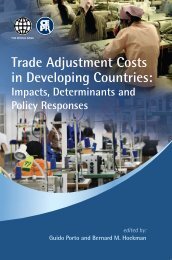Download PDF - Vox
Download PDF - Vox
Download PDF - Vox
- No tags were found...
You also want an ePaper? Increase the reach of your titles
YUMPU automatically turns print PDFs into web optimized ePapers that Google loves.
The Future of the WTO4.2 The nature of trade barriers and trade policies changesEmergence of the trade-investment-services-IP nexus meant that trade now involvedtwo new necessities – connecting factories, and doing business abroad. Underpinningthese involved rules on things that were never considered trade issues in the GATT era.1. Connecting factories involves assurances on business-related capital flows, worldclasstelecoms, air cargo, overnight parcel services, customs clearance services,short-term visa for managers and technicians, and infrastructure (ports, road, railand electricity reliability, etc.). Of course, tariffs and other border measures alsomatter.2. Doing business abroad involves a whole range of formerly domestic policies – socalledbehind-the-border barriers such as competition policy, property rights, rightsof establishment, the behaviour of state-owned enterprises, the protection of intellectualproperty, and assurances on investor rights. All of these are important todoing business abroad.In this new world, any policy that hinders the nexus is now a trade barrier.The second unbundling created a de novo impulse for liberalisation – developing nationswanted the offshored industrial jobs and technology, rich-nation firms wanted accessto lower-cost labour. Both pushed for disciplines to underpin the trade-investmentservices-IPnexus. The result was “deep” regional trade agreements and unilateral probusinessreforms by developing nations. The result can be seen in Figure 1 – the WTO’sdifficulty with the Doha Round did nothing to slow global trade liberalisation.The political economy of liberalisation also changed. It was no longer the juggernaut’s“I’ll open my market if you open yours”, but became a reciprocal deal based on “foreignfactories for domestic reforms”. Developing nations were willing to reform all sorts ofbehind-the-border barriers in exchange for factories and industrial jobs that came fromjoining a rich-nation’s supply chain.129














